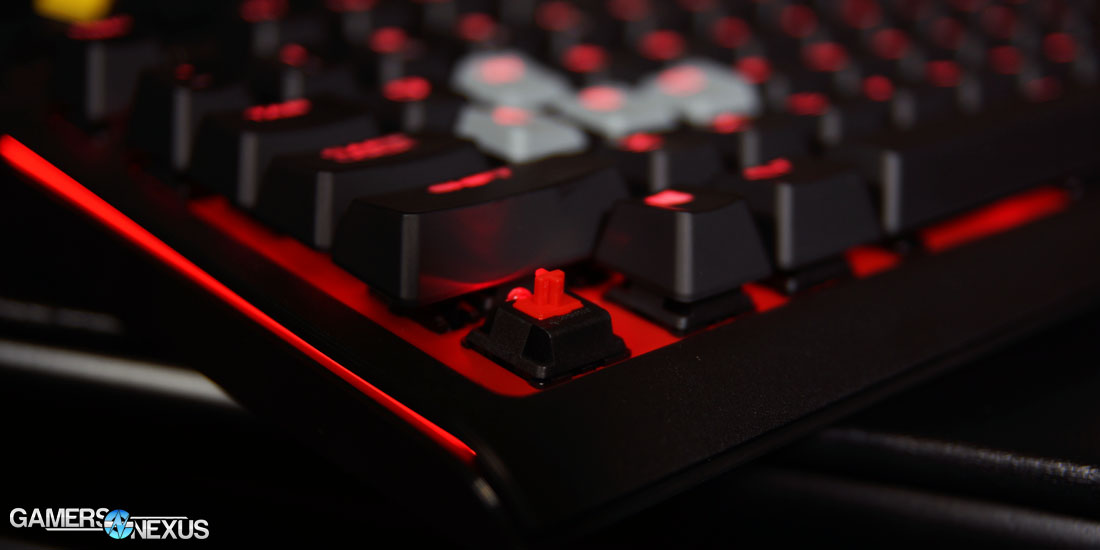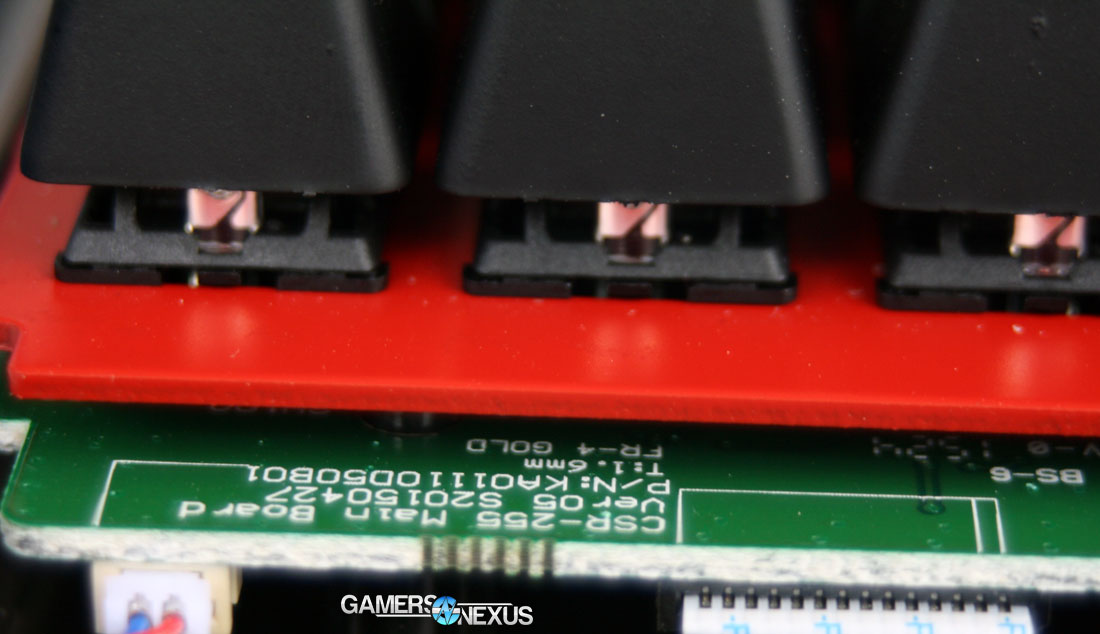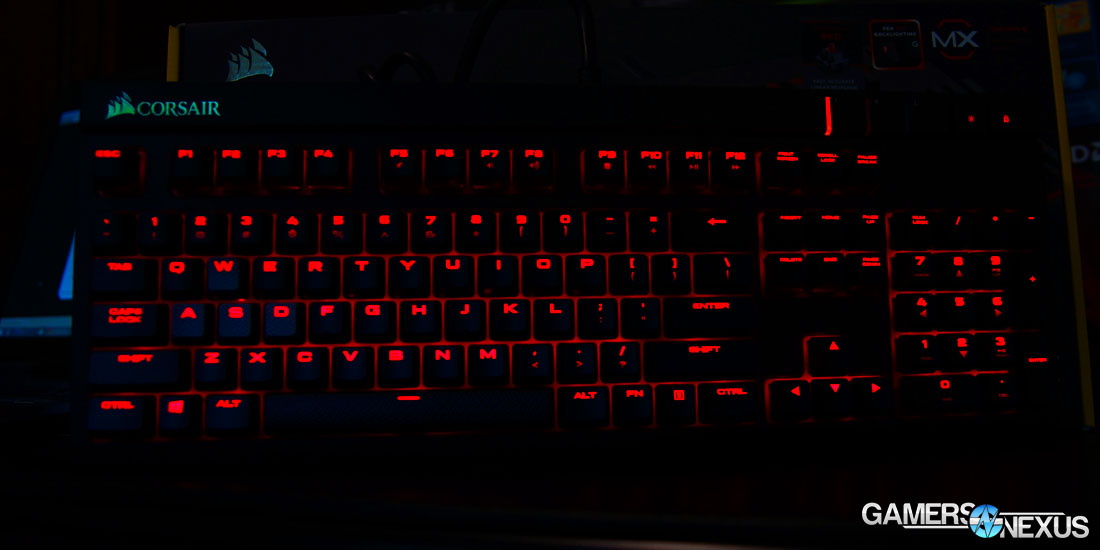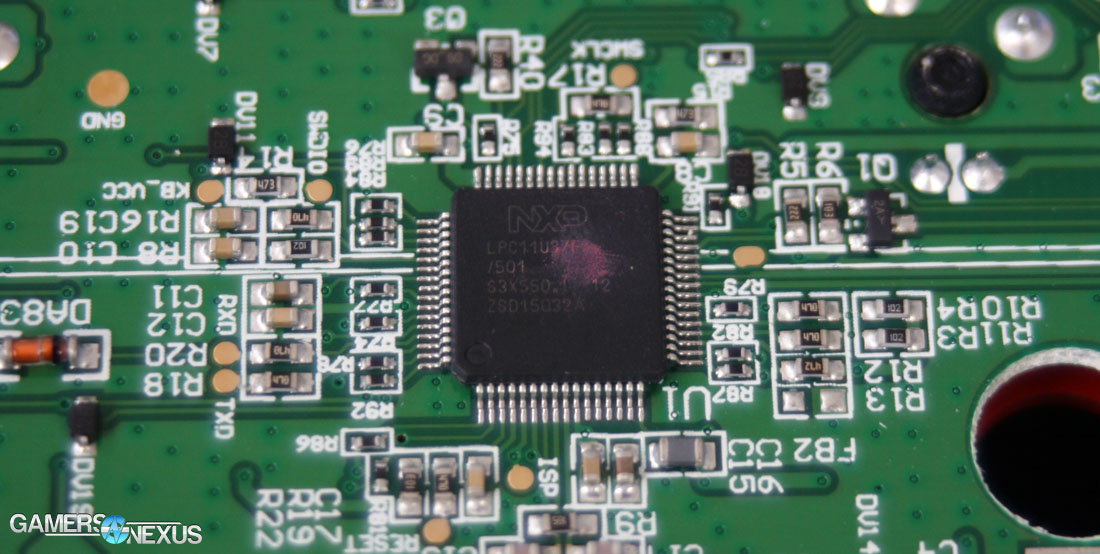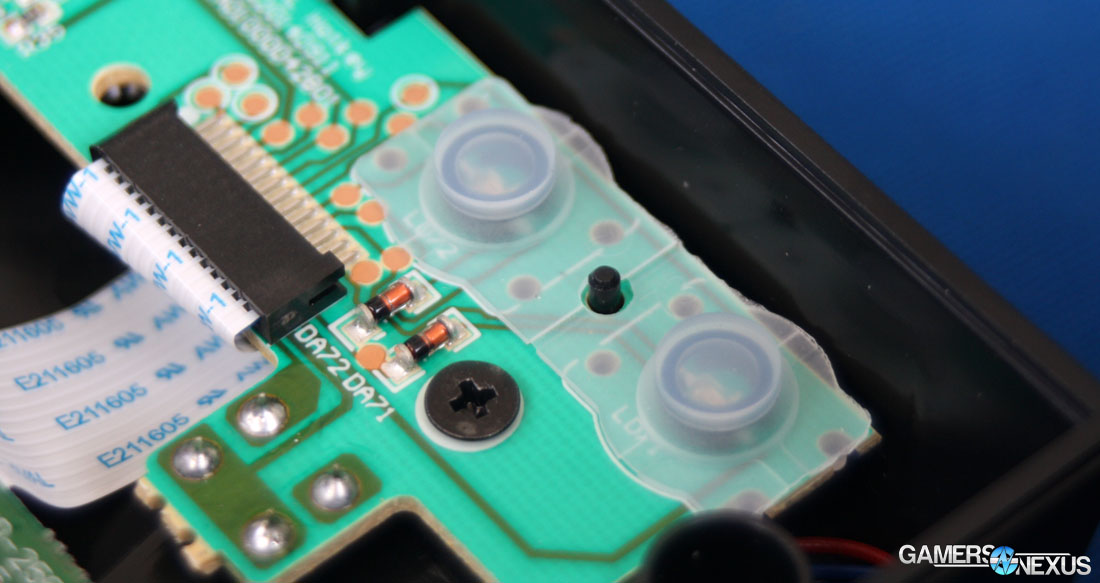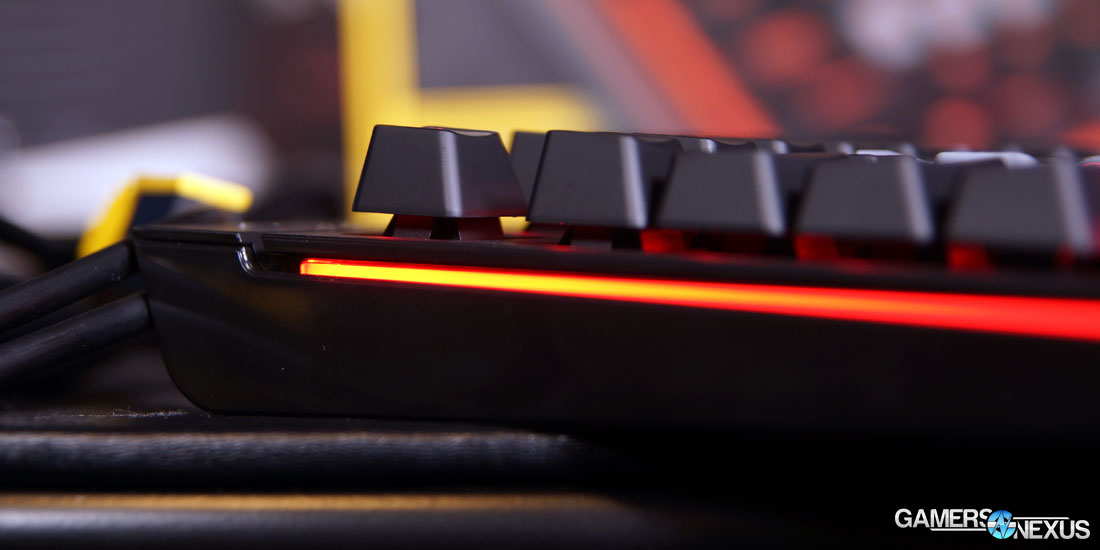Corsair has become a prominent gaming brand in recent years, with expansion into cases (they didn’t always make them) and peripherals. One of Corsair’s strongest pursuits has been mechanical keyboards. The company recently released its Strafe mechanical keyboard, and announced a soon-to-be-released RGB Strafe. In preparation for the RGB variant, we’ve used, dissected, and reviewed the Corsair Strafe mechanical keyboard.
The Strafe is Corsair’s response to a lack of a lower-budget, mechanical gaming keyboards in their product vertical. Corsair’s Strafe comes with Cherry MX Brown or Red switches, has a plastic enclosure, and hosts customizable lighting through the Corsair Utility Engine (CUE) software. The Corsair Strafe has an MSRP of, and currently retails for, $110 via retailers.
Corsair Strafe Mechanical Keyboard Specs
- Cherry MX Brown or Red switches
- Customizable red backlight
- USB passthrough
- FPS/MOBA textured key replacements (and key-puller)
- 104-key rollover
- Media keys
- 2-year warranty
Typing Experience, Media Keys, and USB Passthrough
Our Corsair Strafe uses Cherry MX Red switches. The Cherry MX Red switches provide light, linear typing that is also decently quiet – assuming one doesn’t hammer the keys. Some keyboards can exhibit what’s sometimes referred to as “key-chatter,” which describes a “ringing” in Cherry MX switch springs due to typing. Design plays a part in whether this is present in a keyboard. So far, I’ve had no issues with this in the Corsair Strafe, even when typing very hard and rapidly.
The Cherry-style stabilizers for the larger keys are linear and don’t significantly affect the switch feeling, although they do legitimately stabilize the larger keys (space, shift). My experience typing with the Corsair Strafe has thus far been satisfactory -- even minor issues I’ve had with other keyboards aren’t present.
The media keys on the Corsair Strafe aren’t dedicated; instead, they are function + F-row keys that have secondary media functions. This is very common and was seen in our Tt eSports Poseidon review and, while dedicated media keys are better, Corsair likely excluded them due to the increased cost or size requirements.
Interestingly, Corsair has a USB pass-through on the Strafe. It’s nothing revolutionary, but it is a convenient feature that is somehow absent on Corsair’s RGB keyboards – perhaps it will show up in later versions. Pass-throughs with power demands require multiple USB connections-to-host, which can sometimes be more annoying than functional. It mostly depends on the user.
Keycaps
Yes, keycaps: Oftentimes a subject of little thought, but keycaps do matter -- especially so on backlit keyboards that illuminate the legend. The Strafe’s keycaps are thin, (what seems to be) ABS plastic, painted keycaps. Thin ABS painted keycaps are very common in keyboards. The keycaps themselves are clear, so with the legend depicted via absence of paint, the red LEDs are able illuminate the legends well.
The Corsair Strafe also comes with FPS/MOBA keycaps and a keypuller. These keycaps are basically just angled keycaps for the WASD and MOBA-used keys.
My only issue with the keycaps is the non-standard bottom row. For mechanical keyboards there are generally accepted, standard key sizes. This allows for easily replacing keycaps with other sets. The non-standard bottom row means that it is much harder to find replacement keycaps for the Corsair Strafe. While some users won’t mind this (since they don’t replace their keycaps with other sets), for those who want to swap keycaps, the non-standard bottom row will likely prove a nuisance.
Lighting
One of the primary features of the Corsair Strafe is programmable LED lighting. The lighting is controlled via the Corsair Utility Engine (CUE), which I cover below this section. The LEDs themselves are reasonably bright and have four levels of brightness (including off). This is a little limiting as slow ripples and gradients have fairly obvious stepping, but it still allows for enough versatility in effects.
The LEDs are placed at the back of the switches, meaning they can’t illuminate towards the user. This leads to the front of the switches casting a shadow where the red LEDs don’t illuminate. This is improved in the newer RGB Cherry MX switches, but since the Corsair Strafe doesn’t use those, they’ve instead opted to diminish this effect through the use of a red-painted backplate. The use of a red backplate makes the shadows less obvious since, even where there are shadows due to switch housing, it’s still red by nature.
The Corsair Strafe also has toggle-able LED light pipes on the left and right side of it. The piped lighting is evenly distributed and looks good, although it is a bit disappointing the only brightness options are on or off.
Corsair Utility Engine
The Corsair Strafe has the majority of its lighting control done via the Corsair Utility Engine. The only on-keyboard lighting control is a brightness button. CUE is surprisingly user-friendly for basic lighting and macro control, but also allows for complex customization. Creating and applying user-made lighting modes is a bit of a pain mitigated only by user guides on Corsair’s site. Macros, text input, keystrokes, shortcuts, DPI adjustment, timers, mouse actions, and media control are all programmable and assigned to different keys. Any key can be remapped.
The lighting control has both basic and advanced modes. “Basic” has the standard effects along with basic settings, like how fast a ripple travels across the keyboard. “Advanced” isn’t incredibly user-friendly, but allows for much more customization. It is a little hard to get used to applying settings, but once I got used to it, I had fun creating my rave-like lighting effects. Keep in mind that the only color here is red and that there are only four brightness levels; still, we were impressed with the amount of lighting customization possible.
CUE is also used for setting the polling rate, updating firmware, setting keyout, importing profiles, exporting profiles, and even viewing system information.
I’ve had few issues with CUE. Other than initial difficulty figuring out how to use it (which was fixed through reading the manual), my only problem has been moving the window. On my laptop, instead of being able to smoothly click and drag the window, it jumps across my screen randomly. It still moves the window, granted, but it does so in a jumpy and sporadic fashion.
CUE is extremely useful and goes beyond its expected functionality. I’ve experienced only the one issue, and it’s only mildly annoying.
Build Quality & Aesthetics
Corsair’s high-end keyboards use a primarily aluminum construction. Given the Strafe’s more budget-oriented products, it instead uses a primarily plastic enclosure with a metal backplate for stability and rigidity. The plastic is black with a slight texture to it. It’s not very reflective and doesn’t collect grease or dust easily. The plastic is durable and strong, and attaches to the main body through a system of screws and clips.
Corsair’s deployed metal backplate adds to the rigidity and heft of the keyboard. With the combination of strong plastic and the metal backplate, the Corsair Strafe comes off as resilient and sturdy -- desirable qualities for a keyboard. The build quality of the Corsair Strafe is better than many other mechanical keyboards around the $100 price point, and meets what I expect of a quality keyboard.
The internal build quality is a reflection of the external. All the soldering is neat, the assembly is easily accessed by users, and screws aren’t difficult to get at. The Strafe uses an NXP LPC11U37F-501 processor. It also looks to be using a single Panasonic 32181 for the lighting. These are the same controllers as used in the higher-end RGB K-series keyboards, although those do use more than one Panasonic 32181 controller.
There are two rubber dome switches for the windows lock and lighting toggle (on the top right). Due to the profile of the keys, using a Cherry MX switch isn’t possible in these locations, and to alter the design to include one would look a bit strange. I point this out only because Corsair’s marketing very prominently says, in all caps, “REAL MECH OR NOTHING” on the website. No issue -- just an amusing irony. They are pretty good for rubber domes, though.
The cable on the Corsair Strafe is a bit interesting. Since Corsair uses two USB plugs (one for data, one for power), the cable is excessively thick. This certainly isn’t bad -- in fact, it’s encouraging -- it is just a little amusing that a keyboard has a wire as thick as my PSU’s power cable. The wire is simple rubber, but thick and well-secured.
The design of the Strafe keyboard is reserved -- assuming the LEDs are turned off -- though definitely edges toward “flashy.” I personally enjoy the style; this is ultimately a user decision, so we’ll leave that there. In the least, though, I do know some users will appreciate the use of the Corsair’s new sails logo rather than their oddly “controversial” tribal tattoo crab logo.
Conclusion
When I initially used the Corsair Strafe, I had forgotten what it retailed for ($110). After using it for a couple of days, I remembered the price and found myself surprised. I expected the Corsair Strafe to be more expensive. The Strafe is tastefully styled, sturdy, very customizable, and feature-rich. The only issues I had were the non-standard bottom row, limited 4 levels of brightness, and a software bug that was only a minor annoyance. The the only issue that isn’t fixable, or understandable at the price point, is the non-standard bottom row, and that’s not even an issue for users who don’t replace keycaps. The Corsair Strafe is well-made, demonstrated with its subtle touches -- like the red backplate to minimize cast shadows.
The value of the Corsair Strafe becomes more apparent when looking at the competition. One of the largest competitors to the Strafe is the Cougar 700K at $100. Its style is radically different, although its dedicated media and macro keys are potentially advantageous. Despite this, the Corsair Strafe holds its ground with the versatility of CUE, longer warranty, and much more reserved design.
Aside from Cougar, Corsair’s own Vengeance K70 at $120 is actually one of the Strafe’s chief competitors. The design and feature sets are similar. The K70 does have the advantage of an aluminum construction, wrist rest, and dedicated media keys. If a price bump is possible, this would be a go-to alternative.
The Corsair Vengeance K70 launched with a MSRP of $130 and has dropped to $120, and we expect that the Corsair Strafe will drop in price as time passes, which will put it at an even more competitive price than its current $110. At $110, if somebody is looking for a keyboard with customizable red backlighting and a reserved style, the Corsair Strafe does well and earns our recommendation.
We’ve awarded Corsair’s Strafe keyboard with our “Quality Build” and “Editor’s Choice” awards for its thought-out, near-perfect execution of design and function.
- Michael "The Bear" Kerns.
